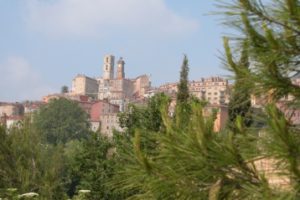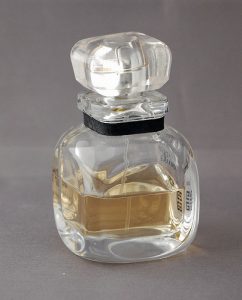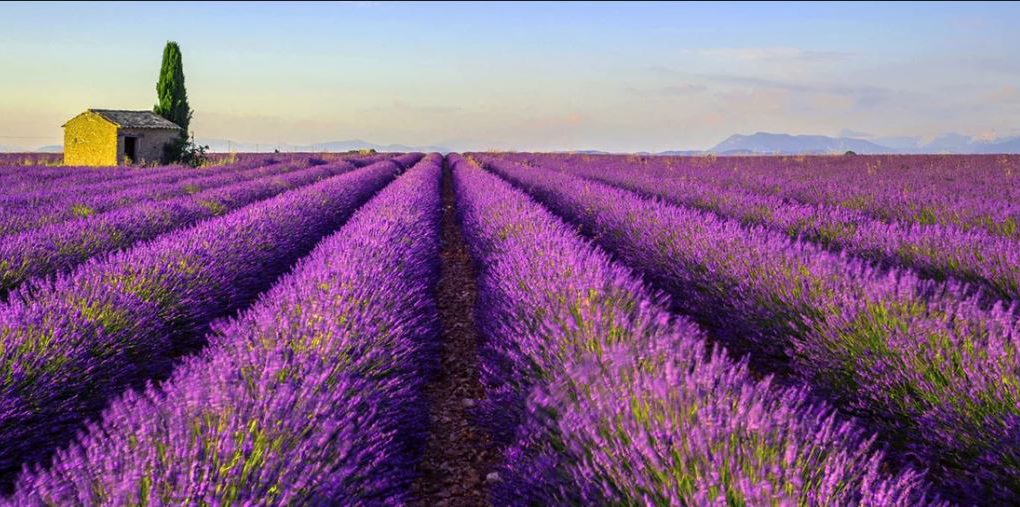Historically, France is the biggest exporter of fragrance, particularly in the town of Grasse in the Provence region, which is home to many fragrant herbs, such as lavender. We continue to use French terms today. There is virtually no difference between perfume and parfum. Parfum is the French term for perfume, so they can be used interchangeably. But these should not be confused with eau de parfum, which is a different product.
Grasse
 Grasse has had a prospering perfume industry since the end of the 18th century. Grasse is the centre of the French perfume industry and is known as the world’s perfume capital (la capitale mondiale des parfums). Many “noses” (or, in French, “Les nez” (plural)/”Le nez” (singular)) are trained or have spent time in Grasse to distinguish over 2,000 kinds of scent. Grasse produces over two-thirds of France’s natural aromas (for perfume and for food flavourings). This industry turns over more than 600 million euros a year. Grasse’s particular microclimate encouraged the flower farming industry. It is warm and sufficiently inland to be sheltered from the sea air. There is an abundance of water, thanks to its situation in the hills and the 1860 construction of the Siagne canal for irrigation purposes. The town is 350 m (1,148.29 ft) above sea level and 20 km (12 mi) from the Coast (Côte d’Azur). Jasmine, a key ingredient of many perfumes, was brought to southern France by the Moors in the 16th century. Twenty-seven tonnes of jasmine are now harvested in Grasse annually. There are numerous old ‘parfumeries‘ in Grasse, such as Galimard, Molinard and Fragonard, each with tours and a museum.
Grasse has had a prospering perfume industry since the end of the 18th century. Grasse is the centre of the French perfume industry and is known as the world’s perfume capital (la capitale mondiale des parfums). Many “noses” (or, in French, “Les nez” (plural)/”Le nez” (singular)) are trained or have spent time in Grasse to distinguish over 2,000 kinds of scent. Grasse produces over two-thirds of France’s natural aromas (for perfume and for food flavourings). This industry turns over more than 600 million euros a year. Grasse’s particular microclimate encouraged the flower farming industry. It is warm and sufficiently inland to be sheltered from the sea air. There is an abundance of water, thanks to its situation in the hills and the 1860 construction of the Siagne canal for irrigation purposes. The town is 350 m (1,148.29 ft) above sea level and 20 km (12 mi) from the Coast (Côte d’Azur). Jasmine, a key ingredient of many perfumes, was brought to southern France by the Moors in the 16th century. Twenty-seven tonnes of jasmine are now harvested in Grasse annually. There are numerous old ‘parfumeries‘ in Grasse, such as Galimard, Molinard and Fragonard, each with tours and a museum.
The trade in leather and tanning work developed during the twelfth century around the small canal that runs through the city. This activity produced a strong unpleasant odor. At the time of the Renaissance perfume manufacturers began production of gloves, handbags and belt (clothing), to meet the new fashion from Italy with the entourage of Queen Catherine de Medici.
The countryside around the city began to grow fields of flowers, offering new scents from the city. In 1614, the king recognized the new corporation of “glovers perfumers”. In the middle of the eighteenth century, the perfumery was experiencing a very important development. Leading companies dating from this period includes oldest French perfumerie and third oldest parfumerie in Europe Galimard established in 1747. Introduction of new production methods turned perfume making into a real industry that could adapt to new market demands.
In the nineteenth century, the raw materials began to be imported from abroad. During the twentieth century the creation of synthetic products brought the democratization & affordability of perfumes and their spin-offs; (shampoos and deodorants, cream (pharmaceutical) and detergents, food flavoring for cookies, ice cream and dairy products, beverages, convenience foods, confectionery, preserves and syrups). In 1905, six hundred tons of flowers were harvested while in the 1940s, five thousand tons were produced annually. However, in early 2000, production was less than 30 tons for all flowers combined.
Historical Activity
 In the Middle Ages, Grasse specialized in leather tanning. Once tanned, the hides were often exported to Genoa or Pisa, cities that shared a commercial alliance with Grasse. Several centuries of this intense activity witnessed many technological advances within tanning industries. The hides of Grasse acquired a reputation for high quality. But the leather smelled badly, something that did not please the glove wearing nobility. This is when Galimard,a tanner in Grasse came up with the idea of scented leather gloves. He offered a pair of scented gloves to Catherine de Medici who was seduced by the gift. Thereafter, the product spread through the Royal Court and high society, and this made a worldwide reputation for Grasse. The seventeenth century became the heyday of “Glovers Perfumers’. However, high taxes on leather and competition from Nice brought a decline for the leather industry in Grasse, and production of leather fragrance ceased. The rare scents from the Grasse (lavender, myrtle, jasmine, rose, orange blossom and wild mimosa) did win the title for the Grasse as the perfume capital of the world. Harvesting jasmine was a labor-intensive business only a few decades ago. Flowers had to be hand picked at dawn, when their scent is the most developed and immediately to be treated by cold enfleurage.
In the Middle Ages, Grasse specialized in leather tanning. Once tanned, the hides were often exported to Genoa or Pisa, cities that shared a commercial alliance with Grasse. Several centuries of this intense activity witnessed many technological advances within tanning industries. The hides of Grasse acquired a reputation for high quality. But the leather smelled badly, something that did not please the glove wearing nobility. This is when Galimard,a tanner in Grasse came up with the idea of scented leather gloves. He offered a pair of scented gloves to Catherine de Medici who was seduced by the gift. Thereafter, the product spread through the Royal Court and high society, and this made a worldwide reputation for Grasse. The seventeenth century became the heyday of “Glovers Perfumers’. However, high taxes on leather and competition from Nice brought a decline for the leather industry in Grasse, and production of leather fragrance ceased. The rare scents from the Grasse (lavender, myrtle, jasmine, rose, orange blossom and wild mimosa) did win the title for the Grasse as the perfume capital of the world. Harvesting jasmine was a labor-intensive business only a few decades ago. Flowers had to be hand picked at dawn, when their scent is the most developed and immediately to be treated by cold enfleurage.
Modern Industry
A network of sixty companies employs 3,500 people in the city and surrounding area. Additionally about 10,000 residents of Grasse are indirectly employed by the perfume industry. Almost half of the business tax for the city comes from the perfume sector and that is ahead of tourism and services. The main activity of perfumery in Grasse is in the production of natural raw materials (essential oils, concretes, absolutes, resinoids and molecular distillation) and the production of concentrate, also called the juice. A concentrate is the main product that when diluted in at least 80% alcohol provides a perfume. Also food flavorings, which developed since the 1970s, account for over half of production output today.
This represents almost half of the production of French perfumes and aromas and around 7-8% of total global activity. However, during the 1960s and 1970s large international groups gradually bought up local family factories (Chiris, Givaudan-Roure and Lautier, for example). Soon after their production has often been relocated overseas. Just 30 years ago most companies were focused on the production of raw materials. However an overwhelming majority of the modern fragrances contain synthetic chemicals in part or in whole. Grasse perfume companies have therefore adapted by turning to aromatic synthesis and especially to food flavorings and successfully ended a long stagnation. The Grasse perfume industry cannot compete against large chemical multinationals, but it benefits greatly from the advantage of its knowledge of raw materials, facilities, contractors, etc. In addition, major brands such as Chanel have their own plantations of roses and jasmine in the vicinity of Grasse.
Perfumeries
Three perfumeries, Fragonard, Molinard and Galimard opened their doors to the public and offer free tours that explain the processes of producing a perfume. It is possible to create one’s own perfume, eau de perfume or eau de toilette and participate in all stages of manufacture from picking flowers to bottling.
- Galimard Perfumery, established in 1747 by Jean de Galimard provided the Royal Court with ointments and perfumes. It is the third oldest perfume company in the world after Farina gegenüber and Floris of London and was revived after the war by Gaston de Fontmichel and Joseph Roux.
- Molinard was established in 1849 and their perfume bottles were made of Baccarat crystal and Lalique glass. Clients can create their own personalized perfume during the Tarinology fragrance course workshop.
- The Fragonard Perfumery was established in 1926 in one of the oldest factories in the city. Its museum Fragonard Musée du Parfum displays rare objects that explain the history of perfumery, covering 5,000 years.
- International Perfume Museum. Opened in 1989, the museum traces the evolution of techniques during the 5,000 year history of perfumery and the large contribution of the Grasse area to perfume making. It was renovated and expanded (doubling in size) between 2007 and 2008.
